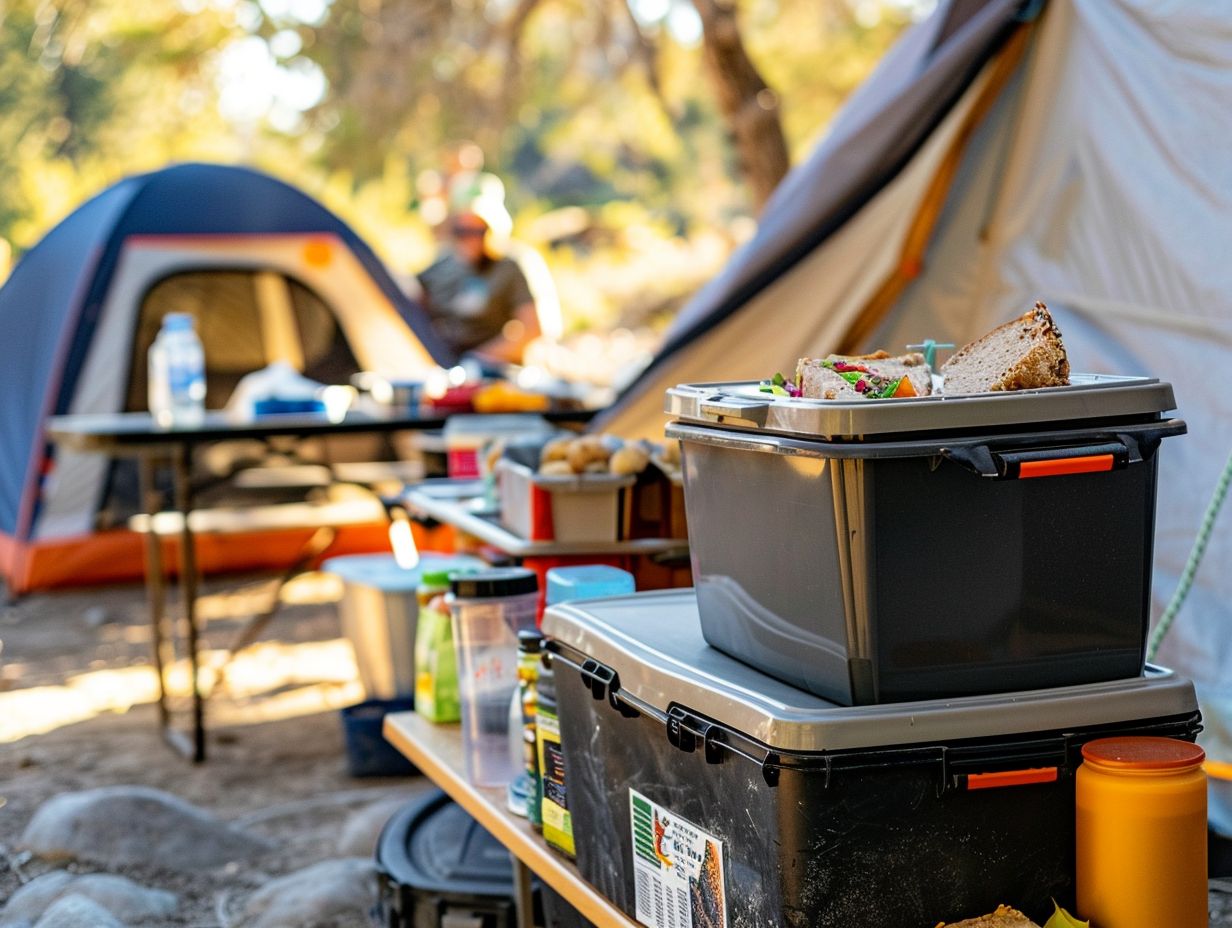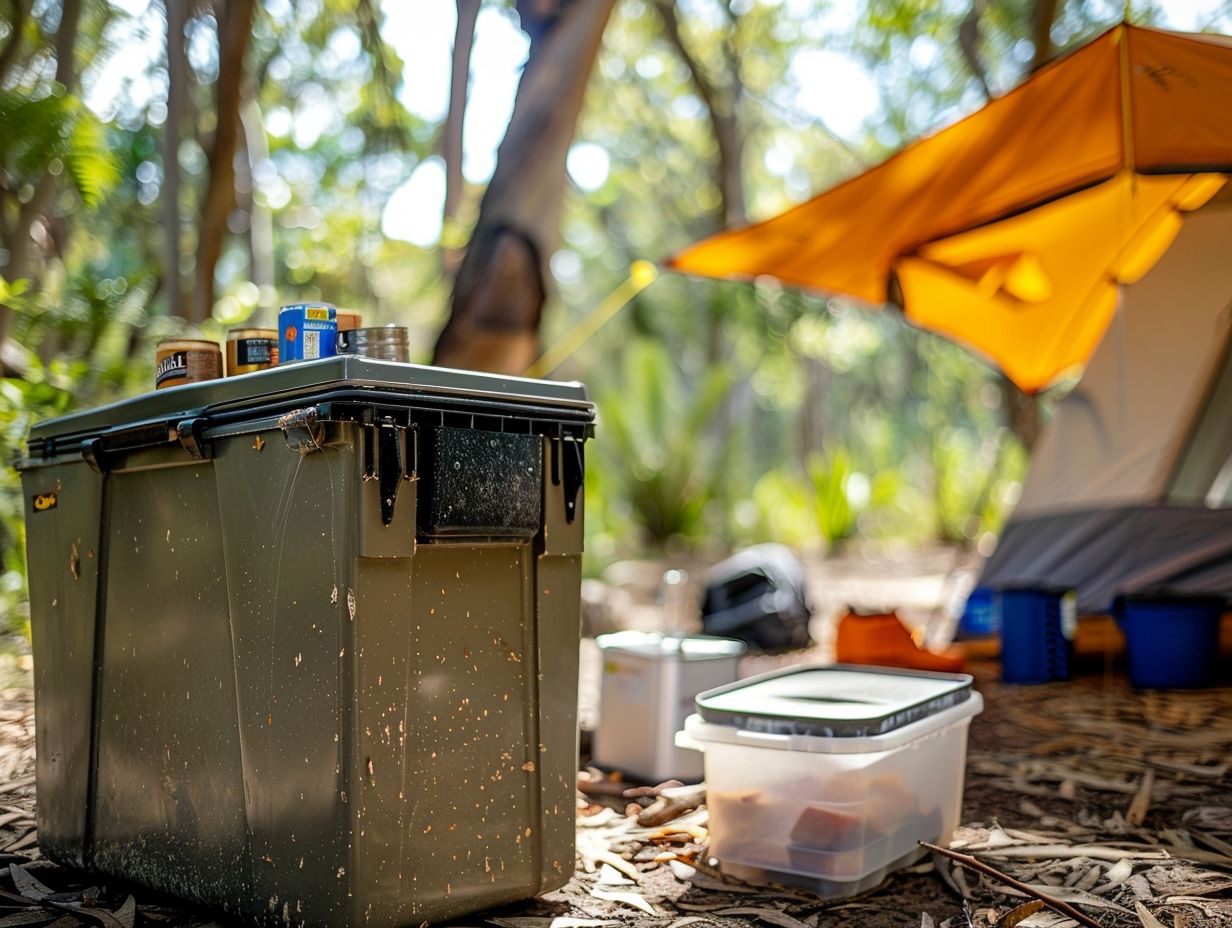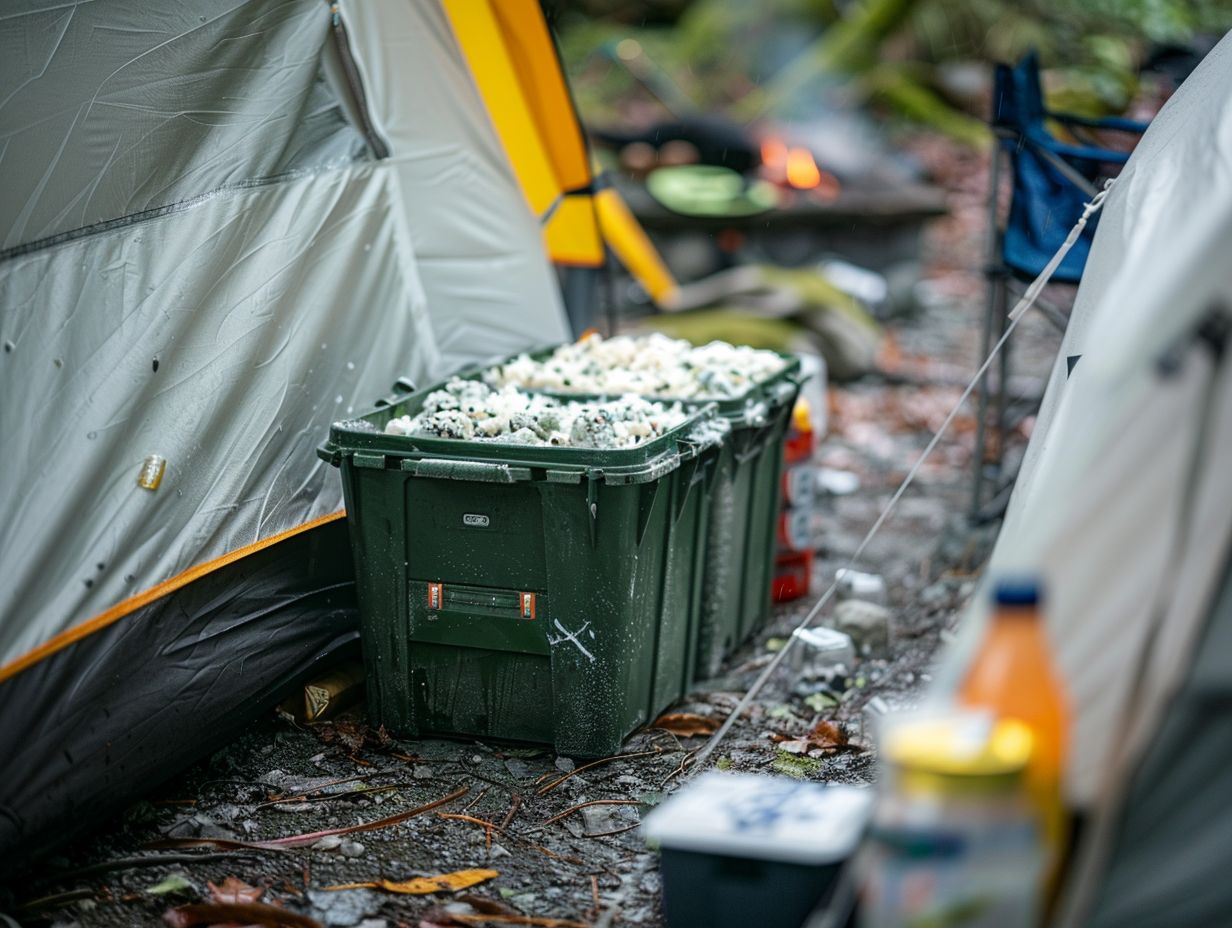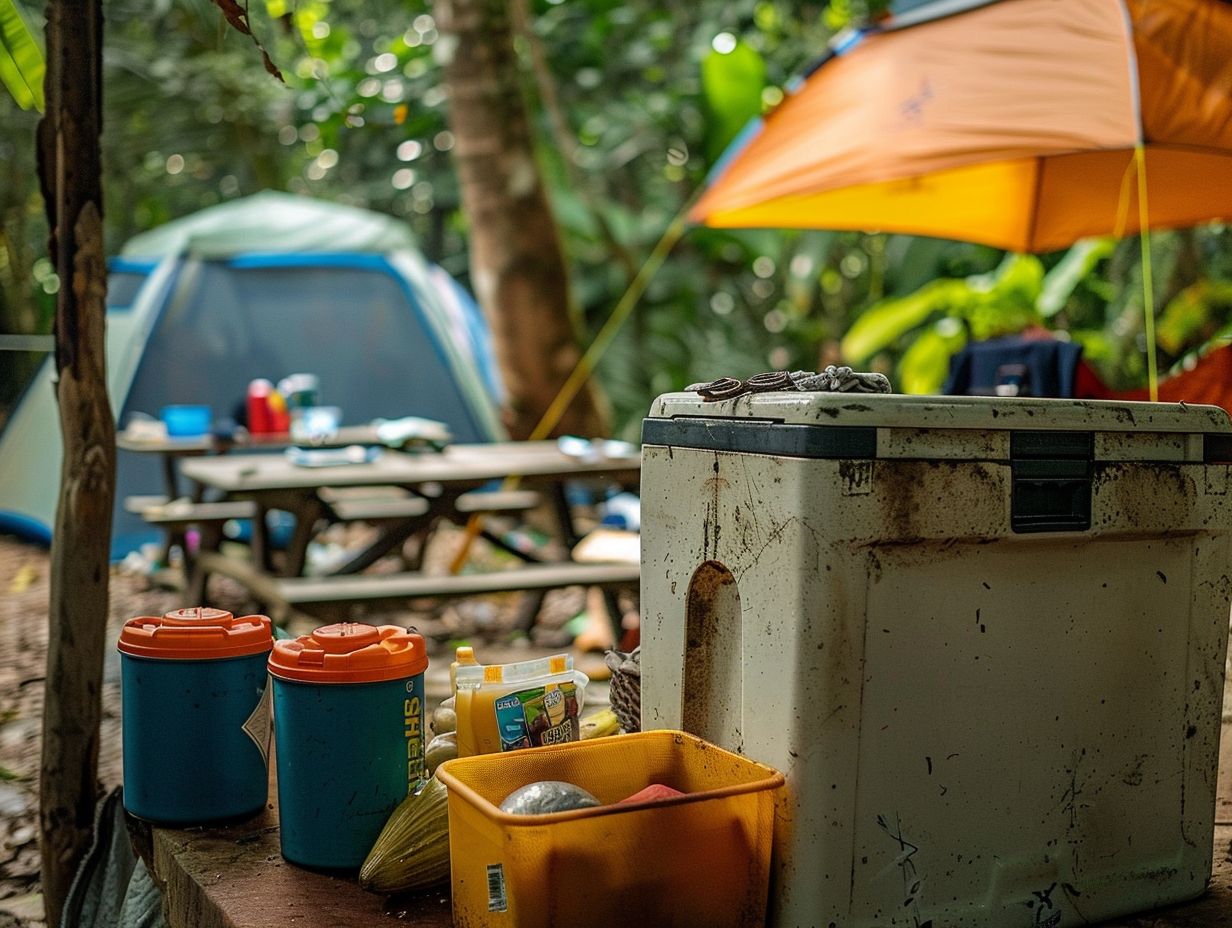Are you planning a camping trip and seeking guidance on how to maintain the safety and freshness of your food? This article presents 15 indispensable tips for properly storing food during camping excursions.
Whether you possess extensive camping experience or are a novice in this realm, adhering to these guidelines will guarantee the preservation of your food’s safety and flavor throughout your outdoor escapade.
Let us explore these valuable tips together.
Key Takeaways:

- Keep your food safe while camping by using airtight containers to prevent contamination from bacteria and animals.
- Ensure that your food stays fresh by storing it in a cooler with ice and keeping it away from direct sunlight.
- Follow proper food safety measures by keeping raw and cooked foods separate and labeling and dating your food when storing it while camping.
1. Use Airtight Containers
Proper food storage in your household should always start with the use of airtight containers. This practice is essential for maintaining the freshness of perishable items like meats and dairy products, as well as preventing spoilage.
Airtight containers serve a dual purpose in food storage by not only retaining the freshness of the contents but also acting as a barrier against potential contamination from external elements such as air, moisture, and pests.
For outdoor activities such as camping and backpacking, selecting the appropriate containers can significantly impact the quality of food you enjoy during your trip.
Containers specifically designed for camping are typically lightweight, durable, and compact, making them easy to transport in a backpack or storage compartment. Additionally, these containers are often stackable, optimising space and facilitating efficient organization of food supplies while on the move.
2. Keep Food in a Cooler with Ice
When camping or backpacking, it is essential to keep your food stored in a cool box with ice to maintain freshness and prevent spoilage, particularly for perishable items.
Utilising a cool box with ice helps regulate the internal temperature, ensuring that your food remains within the safe range and prolongs its shelf life.
To optimise your cool box space, it is advisable to pre-chill items before packing, use ice packs in conjunction with loose ice to prevent soggy food, and keep drinks separate from food to minimise frequent opening and closing of the cool box.
Packing items in airtight containers or sealed bags can prevent leaks and cross-contamination. By strategically organising your cool box with these techniques, you can enhance storage efficiency and savour fresh meals during your outdoor excursions.
3. Store Food Away from Direct Sunlight
To ensure the longevity of perishable foods, it is crucial for you to store them away from direct sunlight. Exposure to sunlight can accelerate the breakdown of certain nutrients in food, such as vitamins and antioxidants, leading to a decrease in nutritional value. Additionally, sunlight exposure can promote the growth of harmful bacteria, thus increasing the risk of foodborne illnesses.
For optimal storage conditions, I recommend placing perishable items in a cool, dark area, such as a pantry or refrigerator. Store these items in opaque containers or cupboards to shield them from sunlight. By adhering to these storage practices, you can effectively maintain the quality and safety of your food for extended periods.
4. Keep Food Away from Animals
Proper food storage involves keeping food away from animals to prevent wildlife encounters and ensure the safety of both campers and wildlife in the wilderness.
When camping or hiking in areas with abundant wildlife, failing to secure your food properly can lead to dangerous situations. Wildlife encounters due to improper food storage may not only put you at risk of losing your supplies but also threaten the natural behaviour and habitat of the animals.
Implementing wildlife-proofing techniques such as using bear-proof containers, hanging food bags out of reach, or storing food in lockers can significantly reduce the chances of animals being drawn to your campsite. By taking these preventive measures, you can help maintain a harmonious coexistence between humans and wildlife in the great outdoors.
5. Use a Separate Cooler for Drinks

When preparing for a camping trip, it is advisable to use a separate cool box solely for drinks. This approach will help maintain optimal drink temperatures while preserving the appropriate storage conditions for food items.
By separating drinks and food into different cool boxes, you not only ensure that drinks remain cold but also simplify the organisation of your camping essentials.
Using dedicated cool boxes for drinks and food allows you to prioritize easy access to your favorite drinks without having to search through containers to find them.
This effective organizational method can improve your camping experience, allowing you to relax and enjoy your trip without the hassle of constantly rearranging items in your cool box.
So, when packing for your next camping adventure, remember the practicality of using separate cool boxes for drinks and food.
6. Pack Non-Perishable Foods
Including non-perishable foods in your camping provisions ensures a convenient and reliable source of snacks or meals that do not require refrigeration or special storage conditions.
These items can be a lifesaver for hungry campers after a long day of hiking or exploring nature. Some great non-perishable options to consider are tinned beans, dried fruits, nuts, trail mix, energy bars, packets of instant porridge, and jerky.
To maintain your energy levels during outdoor activities, it’s important to have a balanced mix of carbohydrates, proteins, and healthy fats. Combining items like wholemeal crackers with nut butter, tuna packets, tinned soup, and granola bars can provide the necessary nutrients to keep you fuelled and satisfied.
7. Use Ziploc Bags for Smaller Items
When organising smaller food items efficiently, using Ziploc bags can be a practical solution for keeping items separated and easily accessible within your camping or backpacking supplies.
These versatile bags are ideal for storing condiments, spices, or snacks without occupying too much space. To enhance convenience, it is recommended to label each bag with its contents for easy identification later on.
By categorising items and placing similar condiments or snacks together in labelled bags, meal preparation can become a seamless process. Consider utilising various coloured bags for different categories to swiftly locate the desired items.
With a bit of organisation and foresight, incorporating Ziploc bags can significantly improve the organisation of your smaller food items during your outdoor excursions.
8. Label and Date Your Food
Maintaining food safety and organisation is simplified by labelling and dating your stored food items, allowing for easy identification of contents and tracking of expiry dates. Properly labelling perishable items not only ensures the freshness of your food but also helps in preventing food wastage.
By clearly indicating the date of purchase or expiry, you can easily prioritise items based on their freshness. To effectively label food containers, use waterproof and smudge-proof markers to prevent labels from fading or getting wiped off. Consider using colour-coded labels for different categories of food to enhance visual organisation and quick retrieval.
Regularly check and rotate items to consume them before they expire.
9. Bring a Thermometer for Monitoring Temperature
Monitoring food temperatures is crucial for ensuring food safety during camping trips, making a thermometer a valuable tool for preventing spoilage and contamination. Maintaining proper temperature control is essential for prolonging the freshness of perishable items and reducing the risk of foodborne illnesses.
Utilising a thermometer helps you accurately monitor the internal temperature of foods, particularly meat and poultry, to ensure they are stored at safe levels. For fridges, it is recommended to keep the temperature at 40°F or below, while for freezers, aim for 0°F or lower.
Regularly checking and calibrating your thermometer is necessary to ensure accuracy and effectiveness in preserving the quality of your food.
10. Use Frozen Water Bottles as Ice Packs

Achieving optimal cooler space and preserving food freshness during your camping expedition can be achieved by using frozen water bottles as multi-purpose ice packs and refreshing drinks. Frozen water bottles not only help keep perishable items cold but also act as a convenient source of hydration as they thaw.
To maximise their effectiveness, it is recommended to fill the bottles about three-quarters full to allow room for expansion when the water freezes.
Placing the bottles horizontally in the freezer ensures an even distribution of the cold temperature, and rotating them periodically helps promote uniform freezing.
It is advisable to use bottles of different sizes to fit various spaces in your cooler, creating a well-balanced cooling effect throughout.
11. Keep Raw and Cooked Foods Separate
To prevent cross-contamination and foodborne illnesses, you need to keep raw and cooked foods separate during storage, adhering to optimal food safety standards.
One of the primary risks of mixing raw and cooked foods is the potential transfer of harmful bacteria from raw food to cooked food.
This can result in food poisoning and gastrointestinal problems if the cooked food isn’t heated to a high enough temperature to eliminate any pathogens.
For efficient organisation and storage of different food types, it is recommended to use separate containers or designated sections in the fridge for raw and cooked items.
Using colour-coded cutting boards and utensils for distinct food groups can help prevent cross-contamination during food preparation.
12. Use a Bear-Proof Container if Camping in Bear Country
In bear country, you should safeguard your food supplies by using a bear-proof container to prevent wildlife encounters and promote responsible camping practices in harmony with nature. These specialised containers are designed to withstand the strength and persistence of bears, ensuring that your food remains secure and inaccessible to these animals.
By investing in a quality bear-proof container, you not only protect yourself and your fellow campers from potential dangers but also contribute to the preservation of wildlife habitats.
When choosing a bear-proof container, opt for a model approved by wildlife authorities and large enough to accommodate your food and scented items. Remember to always lock the container securely and place it at a safe distance from your campsite to further mitigate any risks.
13. Store Food in a High Place or Hung from a Tree
When traditional containers are unavailable, consider hanging food in a high place or from a tree as an effective method to prevent wildlife encounters and ensure proper food storage in the wilderness.
When you suspend food out of reach of animals like bears and raccoons, you decrease the chances of unwelcome interactions.
When choosing a spot to hang food, prioritise sturdy tree branches that are at least 10 feet above the ground and 4 feet away from the trunk. Make sure the branch is robust enough to support the weight of your food bag. Avoid locations near cliffs, water sources, or camping areas to avoid attracting animals to your suspended food.
The primary objective is to protect both wildlife and your provisions.
14. Dispose of Food and Packaging Properly
Responsible camping involves ensuring proper disposal of food remnants and packaging to minimise waste, protect the environment, and prevent wildlife attraction to leftover food.
When you are out exploring the great outdoors, it is essential to leave no trace behind to preserve the natural beauty of wilderness areas for future generations.
Sustainable disposal methods for food waste and packaging materials play a crucial role in this conservation effort. By packing your food in reusable containers and avoiding single-use plastics, you can effectively reduce your environmental impact.
After you have finished a meal in nature, make sure to dispose of any leftover food scraps correctly. This can be done by placing them in designated rubbish bins or burying them at least 6-8 inches deep in a hole, away from water sources and campsites.
Non-biodegradable packaging should be carried out and disposed of properly at recycling centers or waste facilities to prevent pollution and protect wildlife.
15. Check Local Regulations and Guidelines for Food Storage

Before embarking on your camping adventure, it is crucial to familiarise yourself with local regulations and guidelines regarding food storage, particularly in national parks or wilderness areas, in order to ensure compliance with safety protocols.
Proper food storage is vital to safeguard not only your safety but also the wildlife and natural habitats in these areas. Inadequately stored food can attract animals, leading to habituation or aggressive behaviour that poses risks to both animals and campers.
By adhering to specific park guidelines on food storage, such as utilising bear-proof containers or hanging food in designated areas, you can help mitigate human-wildlife conflicts and maintain the delicate balance of ecosystems.
These regulations are implemented to uphold the beauty and integrity of these natural landscapes for the benefit of future generations.
Frequently Asked Questions
What are some general tips for safely storing food while camping?
Always store food in airtight containers, keep them away from heat sources, and avoid leaving them out overnight.
How can I keep my food safe from wildlife while camping?
Store food in bear-proof containers or hang them from a tree at least 10 feet off the ground. Never keep food inside your tent.
What are some essential items for safely storing food while camping?
Airtight containers, a cooler with ice, and airtight bags or vacuum sealers are all important for safely storing food while camping.
How can I prevent cross-contamination while storing food at my campsite?
Use separate containers or bags for raw meats and ready-to-eat foods. Always wash your hands before and after handling food.
Is it safe to eat leftovers while camping?
It is generally not recommended to eat leftovers while camping, as they can spoil quickly in outdoor temperatures. It’s better to prepare and store only what you will eat.
What should I do with leftover food at the end of my camping trip?
Dispose of any remaining food properly by either packing it out with you or disposing of it in designated trash cans. Never leave food behind in the wilderness as it can attract animals and create a safety hazard.



